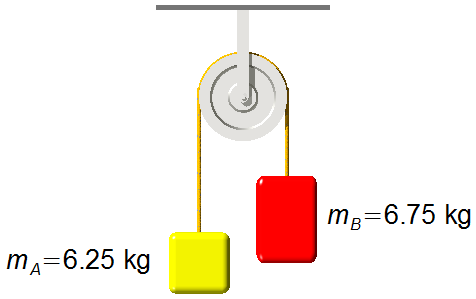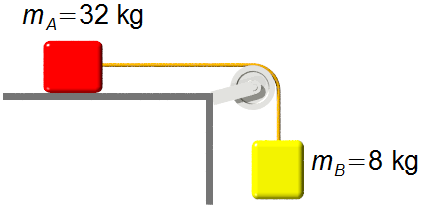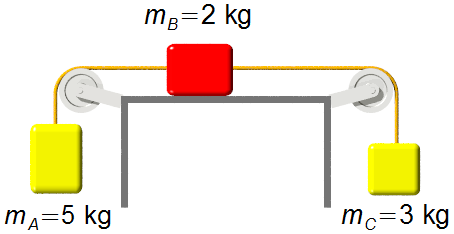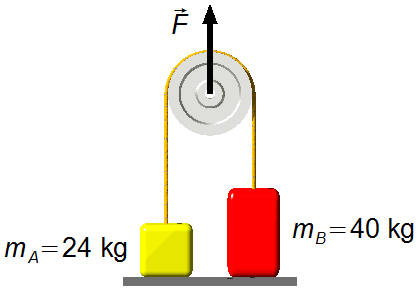Dynamics
advertisement
Basic Concepts
A body of mass 3 kg, initially at rest, is on a frictionless horizontal surface. A horizontal force of
constant magnitude equal to 4.5 N acts on the body for 20 s. Calculate:
a) What is the acceleration of the body while the force acts?
b) What is the speed of the body when the force stops acting?
c) What is the distance traveled by the body until the force stops acting?
a) What is the acceleration of the body while the force acts?
b) What is the speed of the body when the force stops acting?
c) What is the distance traveled by the body until the force stops acting?
Two bodies of masses mA = 6 kg and mB = 4 kg are on a frictionless
horizontal surface. A horizontal force of constant magnitude equal to 25 N is applied to push the two
bodies. Find the acceleration acquired by the set and the magnitude of the contact force between the
bodies.

Two blocks, of masses mA = 0.35 kg and mB = 1.15 kg, are on a
frictionless horizontal surface. The rope that connects the blocks has a negligible mass. A horizontal
force of constant magnitude equal to 15 N is applied by pulling the two blocks. Find the magnitude
acceleration acquired by the system and the tension in the rope connecting the blocks.

A man of mass m = 70 kg, is in an elevator, this one moves with acceleration
a = 2 m/s2, find:
a) The force of the man on the floor of the elevator, if the elevator is accelerating downwards;
b) The force of the man on the floor of the elevator, if the elevator is accelerating upwards;
c) For what acceleration of the elevator will the force of the man on the floor will be equal to zero?
a) The force of the man on the floor of the elevator, if the elevator is accelerating downwards;
b) The force of the man on the floor of the elevator, if the elevator is accelerating upwards;
c) For what acceleration of the elevator will the force of the man on the floor will be equal to zero?
A locomotive, mass 130 t, drags a railroad car, mass 120 t. The maximum force that the locomotive coupler
can withstand is 2,900 kN. Find the maximum driving force that the locomotive can exert in order not to
break the coupler. Disregard resistance forces.
Atwood Machine
An Atwood machine has masses, of mA = 6.25 kg and mB = 6.75 kg,
connected by a weightless cord through a pulley frictionless. Find:
a) The acceleration of the system;
b) The tension in the rope connecting the masses;
c) The tension in the rope that holds the system to the ceiling.
a) The acceleration of the system;
b) The tension in the rope connecting the masses;
c) The tension in the rope that holds the system to the ceiling.

In the system of the figure, body A slides on a horizontal surface without friction, dragged by
body B which moves downward. Bodies A and B are tied by a rope of negligible mass
parallel to the surface and pass through a frictionless pulley of negligible mass. The masses of
A and B are, respectively, 32 kg and 8 kg. Find the acceleration of the system and the
tension on the rope.

In the system of the figure, body B slides on a horizontal surface without friction. It is
connected through ropes and pulleys, lightweight and frictionless, with two bodies, A and C,
that move vertically. The masses of A, B, and C are, respectively, 5 kg, 2 kg, and 3 kg.
Find the acceleration of the system and the tension in the cord.

In an Atwood machine, the two bodies, at rest on a horizontal surface, are connected by a rope of
negligible mass that passes over a frictionless pulley of negligible mass. The masses weight
mA = 24 kg and mB = 40 kg. Determine the body accelerations when:
a) F = 400 N;
b) F = 720 N;
c) F = 1200 N.
a) F = 400 N;
b) F = 720 N;
c) F = 1200 N.

advertisement

Fisicaexe - Physics Solved Problems by Elcio Brandani Mondadori is licensed under a Creative Commons Attribution-NonCommercial-ShareAlike 4.0 International License .